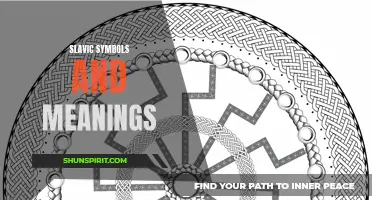
The mystical allure of the Phoenix, a legendary creature that rises from the ashes, has fascinated cultures across the globe for centuries. With its vibrant plumage, regal stance, and extraordinary ability to resurrect itself, the Phoenix symbolizes resilience, rebirth, and transcendence. From ancient mythology to modern-day interpretations, this iconic bird's significance resonates with our innate desire to overcome adversity and embrace transformation. Join me as we delve into the captivating world of Phoenix symbolism and explore the rich layers of meaning associated with this mythical creature.
What You'll Learn
- What are some common symbols associated with the phoenix?
- In what cultures or mythologies is the phoenix commonly found?
- What is the significance of the phoenix's ability to be reborn from its own ashes?
- How has the phoenix been depicted in art and literature throughout history?
- How does the phoenix symbolize renewal and transformation in spiritual or symbolic contexts?

What are some common symbols associated with the phoenix?
The phoenix is a mythical bird that is often associated with rebirth, immortality, and renewal. It has been a powerful symbol in various cultures and has inspired many different representations and interpretations. Here are some common symbols that are often associated with the phoenix:
- Fire: The phoenix is commonly depicted engulfed in flames or rising from the ashes. Fire symbolizes destruction and purification, and the phoenix's ability to rise from the ashes represents its eternal cycle of life, death, and rebirth.
- Wings: The phoenix is often depicted with large, majestic wings that represent freedom, transcendence, and the ability to rise above challenges. The wings also symbolize the phoenix's connection to the heavens and its ability to travel between the mortal world and the divine realm.
- Gold and Red Colors: These colors are commonly associated with the phoenix. Gold represents wealth, abundance, and the sun, while red symbolizes passion, strength, and vitality. The combination of these colors signifies the phoenix's vibrant and regenerative nature.
- Sun: The phoenix is often associated with the sun due to its connection to fire and light. The sun represents enlightenment, life-giving energy, and the source of all creation. The phoenix's association with the sun emphasizes its divine and powerful nature.
- Tree of Life: In some cultures, the phoenix is depicted perched on top of the Tree of Life. The Tree of Life symbolizes the interconnectedness of all living beings and the cyclical nature of life and death. The phoenix's presence on the Tree of Life represents its role in the eternal cycle of creation, destruction, and rebirth.
- Feathers: The phoenix is often depicted with vibrant and colorful feathers. Feathers symbolize lightness, grace, and spirituality. The phoenix's feathers are said to possess magical properties and are believed to have healing or protective powers.
- Lotus Flower: In some Eastern cultures, the phoenix is associated with the lotus flower, which is considered a sacred symbol of purity, enlightenment, and rebirth. The lotus flower grows out of muddy waters and blooms into a beautiful flower, symbolizing the journey from darkness to light.
- Circle or Spiral: The phoenix is often depicted in the shape of a circle or a spiral. These shapes represent the cyclical nature of life, with no beginning or end. They also symbolize infinity, balance, and harmony.
These are just a few of the common symbols associated with the phoenix. The phoenix's symbolism may vary depending on the culture or mythology it is referenced in. Nevertheless, the overall message behind the phoenix remains the same – the ability to rise from the ashes and start anew, representing hope, transformation, and the enduring power of the human spirit.
The Deep Meaning Behind the Nursing Symbol
You may want to see also

In what cultures or mythologies is the phoenix commonly found?
The mythical creature known as the phoenix is a symbol of rebirth and immortality. It is commonly found in various cultures and mythologies across the world. Let's explore some of the cultures and mythologies where the phoenix holds a significant role.
Ancient Egypt:
In Egyptian mythology, the phoenix is known as Bennu. It is associated with the sun god Ra and is often depicted as a heron-like bird with a crest of feathers on its head. The Bennu bird was believed to be a symbol of rebirth and was associated with the cycle of death and resurrection.
Greek Mythology:
The phoenix also has a prominent place in Greek mythology. It is often linked with the sun god Apollo and is said to live for hundreds of years before immolating itself in fire and then being born again from its own ashes. The Greek word for phoenix is "phoinīx," which means "crimson or purple-red." This vibrant color symbolism adds to the mystical qualities of the creature.
Chinese Mythology:
In Chinese mythology, the phoenix is known as Fenghuang. It is often paired with the dragon and is considered a symbol of yin and yang, representing the balance of male and female energies. The Fenghuang is believed to bring peace, prosperity, and good fortune. It is depicted as a magnificent bird with five colors - black, white, red, yellow, and green.
Persian Mythology:
The phoenix has a rich history in Persian mythology, where it is called Simorgh. It is described as a benevolent creature with the power to heal the sick and wounded. The Simorgh is considered an emblem of purity and is associated with immortality and longevity.
Native American Mythology:
Several Native American tribes have legends and stories involving a bird similar to the phoenix. For example, the Hupa tribe of California has a myth about a bird called Nokomis, which rises from its own ashes. Similarly, the Ojibwe tribe tells a tale of a bird called Thunderbird, which possesses the ability to resurrect itself.
Hindu Mythology:
In Hindu mythology, the phoenix is known as Garuda. Garuda is a divine bird and the mount of Lord Vishnu, one of the primary deities in Hinduism. It is depicted as a large bird with impressive wings and an eagle-like appearance. Garuda is considered the king of birds and represents power, speed, and strength.
These are just a few examples of the cultures and mythologies where the phoenix holds significance. The legend of the phoenix has captured the imagination of people across time and continues to be a symbol of hope, renewal, and endurance. Each culture adds its unique interpretation and symbolism to this magnificent creature, making it a truly global symbol of rebirth and immortality.
Unveiling the Hidden Symbolism and Meaning Behind Tulips
You may want to see also

What is the significance of the phoenix's ability to be reborn from its own ashes?
The phoenix is a mythical creature that has captivated the imaginations of people for centuries. One of its most notable characteristics is its ability to be reborn from its own ashes. This ability has profound symbolism and significance in various cultures and is often associated with themes of transformation, renewal, and resilience.
In ancient Greek mythology, the phoenix is described as a bird that lives for hundreds of years before it dies in flames. From its ashes, a new phoenix is born, symbolizing the cycle of life and death. This concept of rebirth and regeneration has resonated with people throughout history, as it represents the endless cycle of creation and destruction that is present in nature. In this context, the phoenix's ability to rise from the ashes is seen as a metaphor for the human capacity to overcome adversity and start anew.
The phoenix's rebirth also symbolizes transformation and personal growth. Just as the phoenix undergoes a fiery death and subsequent rebirth, individuals can experience profound transformations and emerge from challenging situations with renewed strength and wisdom. The phoenix reminds us that even in the face of destruction and loss, there is always the opportunity for rebirth and renewal.
In addition to its association with renewal and transformation, the phoenix is also seen as a symbol of resilience and endurance. The fact that the phoenix can rise from its own ashes after being consumed by flames speaks to its indomitable spirit and ability to overcome even the most challenging circumstances. This symbolism has been particularly inspiring during times of great hardship or tragedy, as it serves as a reminder that there is always hope and the potential for a new beginning.
The significance of the phoenix's ability to be reborn from its own ashes extends beyond mythology and has permeated various aspects of human culture. It is often used as a symbol in literature, art, and popular culture to convey themes of resilience, transformation, and the triumph of the human spirit. The phoenix's image can be found in literature such as the Harry Potter series, where it is depicted as a creature with healing tears and is a symbol of hope and courage.
Overall, the phoenix's ability to rise from its own ashes holds deep significance. It reminds us of the cyclical nature of life, the potential for personal growth and transformation, and the power of resilience in the face of adversity. Whether in ancient mythology or modern popular culture, the phoenix continues to captivate us with its ability to defy destruction and emerge anew. Its symbolism serves as a source of inspiration and hope, reminding us to embrace change, overcome challenges, and find strength in our own ability to rise from the ashes.
The Significance of Pride Symbols: Exploring their Meanings and Importance
You may want to see also

How has the phoenix been depicted in art and literature throughout history?
Throughout history, the phoenix has held a prominent place in art and literature. The legendary creature is known for its ability to rise from its own ashes, symbolizing rebirth and renewal. The phoenix has captured the imagination of many cultures and has been depicted in various ways in different artistic and literary works.
In ancient Egypt, the phoenix, known as the Bennu bird, was associated with the sun god Ra. It was believed to be a divine messenger sent to announce the beginning of a new era. The Bennu bird was often depicted with a crown or solar disk on its head, symbolizing its connection to the sun.
In Greek mythology, the phoenix is said to have originated from the city of Heliopolis. It was described as a large, beautiful bird with colorful plumage. The Greek poet Hesiod referred to the phoenix as a creature that lived for hundreds of years before bursting into flames and being reborn from its own ashes.
In medieval Europe, the phoenix became a popular Christian symbol of resurrection and immortality. It was often portrayed in religious art, representing Christ's triumph over death. The phoenix was depicted with wings spread, rising from a pile of ashes, symbolizing the resurrection of Jesus.
During the Renaissance period, the phoenix continued to be a popular subject in art. The Italian painter Piero di Cosimo created a famous painting titled "The Death of the Phoenix," which depicts the mythical bird in the act of self-immolation. Other artists, such as Botticelli and Raphael, also included the phoenix in their works, symbolizing the themes of rebirth and eternal life.
In literature, the phoenix has been a source of inspiration for countless writers. One of the most famous examples is in J.K. Rowling's Harry Potter series, where the phoenix is featured as a loyal companion to the character Albus Dumbledore. The phoenix, named Fawkes, plays a significant role in the story, appearing at key moments to provide support and assistance.
In ancient Chinese literature, the phoenix, known as Fenghuang, is often depicted as a combination of several mythical birds. It is considered a symbol of virtue, femininity, and grace. In Chinese poetry and art, the phoenix is often portrayed alongside the dragon, symbolizing the union of yin and yang.
In modern popular culture, the phoenix continues to captivate audiences. It has appeared in movies, video games, and television shows, often representing themes of rebirth, transformation, and hope. The phoenix's symbolism of rising above adversity and starting anew resonates with people from all walks of life.
In conclusion, the phoenix has been depicted in various ways throughout history in art and literature. From its origins in ancient Egypt and Greece to its symbolism in Christian and Chinese culture, the mythical bird has represented themes of rebirth, renewal, and immortality. Its enduring presence in popular culture is a testament to the timeless appeal and significance of this legendary creature.
Demystifying the Symbols: Understanding the Meaning of Bestway Sand Filter Symbols
You may want to see also

How does the phoenix symbolize renewal and transformation in spiritual or symbolic contexts?
The phoenix is a mythical creature that has long been associated with renewal and transformation in spiritual or symbolic contexts. From ancient civilizations to modern-day interpretations, the phoenix has represented the idea of rebirth and the ability to rise from the ashes.
In many mythologies, the phoenix is depicted as a large, fiery bird with vibrant plumage. It is believed to have the power to regenerate itself by consuming flames and then rising from its own ashes. This cyclical process of death and rebirth has made the phoenix a powerful symbol of transformation and renewal.
In spiritual contexts, the phoenix is often seen as a metaphor for the journey of the soul. It represents the process of spiritual awakening, growth, and the eventual transcendence of the limitations of the physical world. Just as the phoenix emerges from the ashes, the soul is believed to transcend the cycle of birth and death, moving towards a higher state of consciousness.
The phoenix is also associated with the concept of alchemy, a transformative process of turning base materials into something pure and valuable. In alchemical symbolism, the phoenix represents the transformation of the ego into a higher state of being, where one's true self is revealed.
In addition to its association with spiritual and symbolic contexts, the phoenix has also been used as a powerful image of resilience and perseverance in various cultures. The idea of rising from the ashes after a devastating setback or failure resonates with many people, symbolizing their ability to overcome adversity and start anew.
The phoenix is a symbol that can be found in various cultures and traditions, from ancient Egypt and Greece to China and Native American mythology. Each culture may have different interpretations and stories associated with the phoenix, but the underlying theme of renewal and transformation remains consistent.
In conclusion, the phoenix is a powerful symbol of renewal and transformation in spiritual and symbolic contexts. It represents the idea of rising from the ashes, overcoming adversity, and experiencing a transformative journey. Whether seen as a metaphor for the soul's journey or a symbol of resilience, the phoenix continues to inspire and captivate those who seek renewal and transformation in their own lives.
Unraveling the Symbolic Meanings of James Avery Jewelry
You may want to see also
Frequently asked questions
In mythology, the Phoenix is often seen as a symbol of rebirth and renewal. It is said to have the ability to rise from the ashes, being born again after it dies. This symbolism is often associated with the idea of overcoming adversity and starting anew, making the Phoenix a powerful symbol in many cultures.
In spiritual beliefs, the Phoenix is often seen as a symbol of transformation and spiritual growth. It represents the process of shedding old beliefs and habits, and emerging as a stronger, more enlightened being. The Phoenix’s ability to rise from the ashes is seen as a metaphor for the journey of the soul and its ability to transcend difficult experiences.
In literature and art, the Phoenix is often used as a symbol of immortality and eternal life. Its ability to be reborn and regenerate is seen as a representation of everlasting life and the cycles of nature. The Phoenix is often depicted as a majestic and beautiful creature, symbolizing the beauty and grace that can come from overcoming challenges and adversity.
In popular culture, the Phoenix is often used as a symbol of hope and resilience. It is often associated with characters or stories that involve transformation and redemption. The idea of rising from the ashes and starting anew is a powerful motif that resonates with many people, and the Phoenix’s symbolism is often used to convey these themes in movies, books, and other forms of media.







